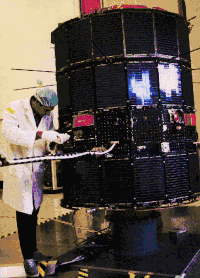Explorer 50
Explorer 50, also known as IMP-J or IMP-8, was a NASA satellite launched to study the magnetosphere. It was the eighth and last in a series of the Interplanetary Monitoring Platform.[8]
 Explorer 50 (IMP-8). | |
| Names | IMP-8, IMP-J |
|---|---|
| Mission type | Magnetospheric research |
| Operator | NASA |
| COSPAR ID | 1973-078A[1] |
| SATCAT no. | 6893[2] |
| Mission duration | 33 years |
| Spacecraft properties | |
| Manufacturer | Goddard Space Flight Center |
| Launch mass | 900 lb (410 kg)[3] |
| Dry mass | 818 lb (371 kg) |
| Dimensions | Polyhedron of 16 faces 157.4 cm (62.0 in) height 135.6 cm (53.4 in) diameter |
| Power | 150 watts |
| Start of mission | |
| Launch date | 26 October 1973, 02:26:03 UTC[4] |
| Rocket | Delta 1604 582/D97[4] |
| Launch site | Cape Canaveral LC-17B[5][6] |
| End of mission | |
| Last contact | 7 October 2006 |
| Orbital parameters | |
| Reference system | Geocentric |
| Regime | High Earth |
| Perigee altitude | 141,185 km (87,728 mi)[7] |
| Apogee altitude | 288,857 km (179,487 mi)[7] |
| Inclination | 28.67°[7] |
| Period | 17,279.0 minutes[7] |
| Epoch | 29 October 1973[7] |
Explorers | |
Launch
Explorer 50 was launched on 23 October 1973 at 02:26:03 UTC, by a Delta 1604 rocket from Cape Canaveral AFS, Florida.[4][9] The spacecraft functioned nominally until 7 October 2006. The satellite orbited the Earth once every 12 days, at an inclination of 28.6 degrees. Its perigee was 22 earth radii and apogee was 45 earth radii.[1][7]
Spacecraft and mission
Explorer 50 was a drum-shaped spacecraft, 135.6 centimetres (53.4 in) across and 157.4 centimetres (62.0 in) height, with propulsion Star-17A, instrumented for interplanetary and magnetotail studies of cosmic rays, energetic solar particles, plasma, and electric and magnetic fields. Its initial orbit was more elliptical than intended, with apogee and perigee distances of about 45 earth radii and 25 earth radii. Its eccentricity decreased after launch. Its orbital inclination varied between 0° and about 55° with a periodicity of several years. The spacecraft spin axis was normal to the ecliptic plane, and the spin rate was 22.3 rpm. The data telemetry rate was 1600 bps. The spacecraft was in the solar wind for 7 to 8 days of every 12 days orbit.
Telemetry coverage was 90% in the early years, but only 60-70% through most of the 1980s and early 1990s. Coverage returned to the 90% range in the mid to late 1990s. The objectives of the extended Explorer 50 operations were to provide solar wind parameters as input for magnetospheric studies and as a 1 AU baseline for deep space studies, and to continue solar cycle variation studies with a single set of well-calibrated and understood instruments. In October, 2001, Explorer 50 was terminated as an independent mission. The last useful science data from Explorer 50 was acquired on 7 October 2006.[1]
Instruments
- MAG (Magnetic Fields Experiment). This instrument studied of the interplanetary space, geomagnetic tail, and boundary magnetic fields. The resolution per sensor is ± 0.3 nT.
- GAF (DC Electric Fields Investigation). This instrument utilizes two 200 feet (61 m) wire antennas to measure DC electric fields in the solar wind and magnetosheath.
- IOF (AC Electric and Magnetic Fields Experiment). The plasma wave instrumentation consists of a 400 feet (120 m) tip-to-tip dipole antenna for electric field measurements (in the S/C spin plane) and a triaxial search coil for magnetic field measurements.[3]
- Plasma
- LAP (Los Alamos Plasma Experiment). The instrument consists of a hemispherical plate electrostatic analyzer for the measurement of ion and electron distributions.
- IOE (Low Energy Particles Investigation). The instrument consists of a Low-Energy Proton and Electron Differential Energy Analyzer (LEPEDA) and a Geiger tube.
PLA (Plasma Faraday Cup Assembly). The objective is to study the positive ions and electrons in the solar wind, transition region, and magnetotail. Parameters derived on a routine basis are proton velocity, number density, and temperature.[3]
- Energetic particles
- EPE (Energetic Particle Experiment). EPE is a solid-state telescope which measures fluxes of ions in four energy channels ranging from 0.05 MeV - 0.20 MeV to 2.1 MeV - 4.5 MeV, and electrons in the ranges 30-90 keV and 100-200 keV.
- EECA (Electrostatic Energy-Charge Analyzer). This instrument consists of 2 detector systems. An electrostatic deflection spectrometer (EDS) measures the energy per charge of incident ions in several ranges between 100 keV and 1000 keV.
- CPME (Charged Particle Measurement Experiment). The instrument is a solid-state telescope measuring fluxes of protons in 11 energy channels between 0.29 and 140 MeV, and alpha particles in 6 channels between 0.64 and 52 MeV/n. Time resolution for the measurement cycle is 10.24 seconds.[3]
See also
| Wikimedia Commons has media related to Explorer 50. |
References
- "IMP-J". NSSDC Master Catalog. NASA Goddard Space Flight Center. Retrieved 2018-06-20.

- "EXPLORER 50 (IMP-8)". n2yo.com. Retrieved 2018-06-20.
- "IMP-8". EO Portal. Retrieved 2018-06-19.
- "Jonathan's Space Page". Jonathan McDowell. Retrieved 2018-06-19.
- "IMP". Encyclopedia Astronautica. Mark Wade. Retrieved 2018-06-20.
- "Explorer 50 / IMP 8". Space Encyclopedia. Claude Lafleur. 2010. Retrieved 2018-06-20.
- "1973-078A - Explorer 50". Space 40 (in Czech). Antonín Vítek. 2005-09-04. Retrieved 2018-06-20.
- "IMP H, I, J". Gunter's Space Page. Gunter Dirk Krebs. Retrieved 2018-06-20.
- "Explorer 50 Rockets Into Orbit". Daytona Beach Morning Journal. 9B. October 26, 1973. Retrieved 20 June 2018.
.png)